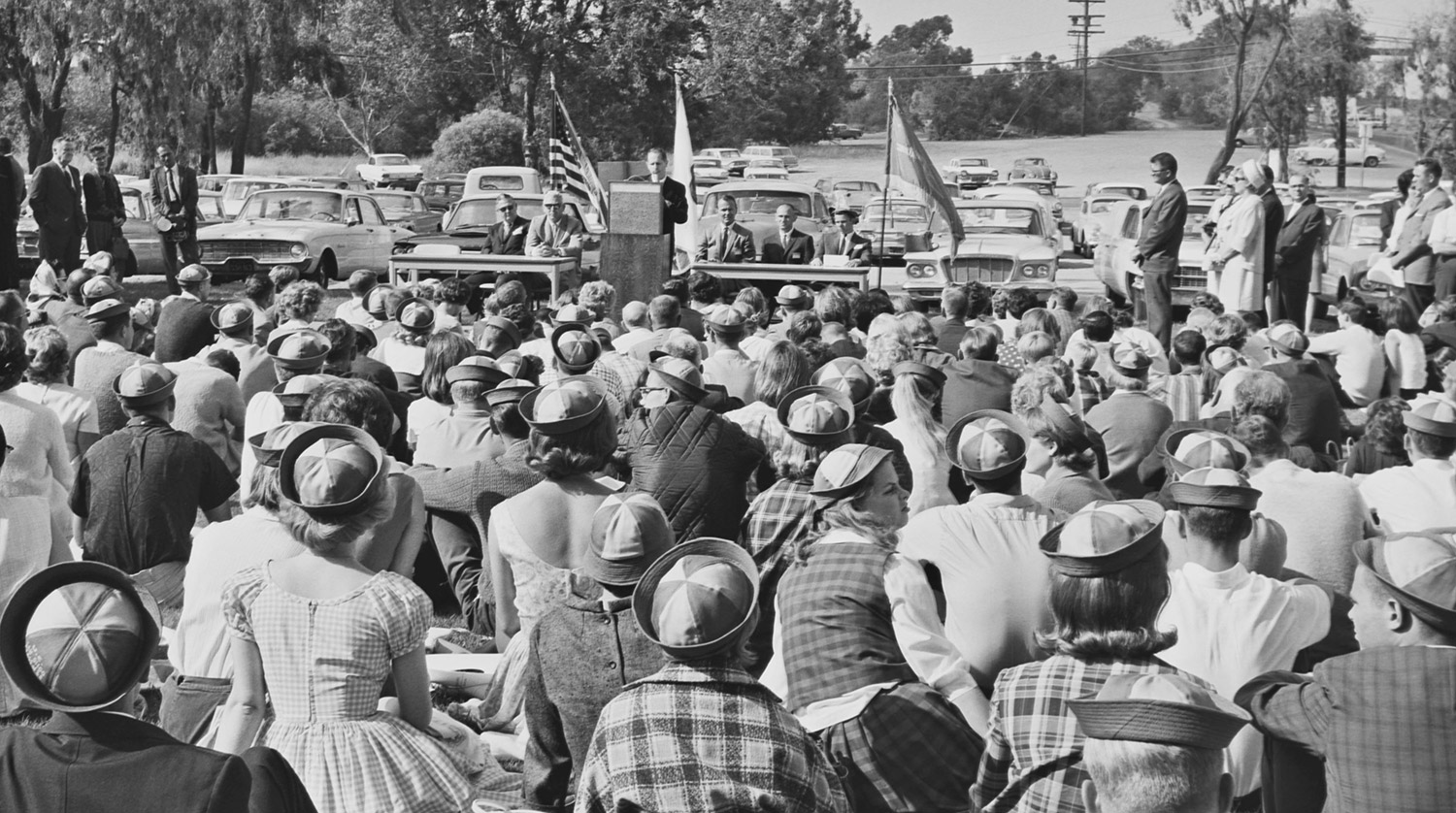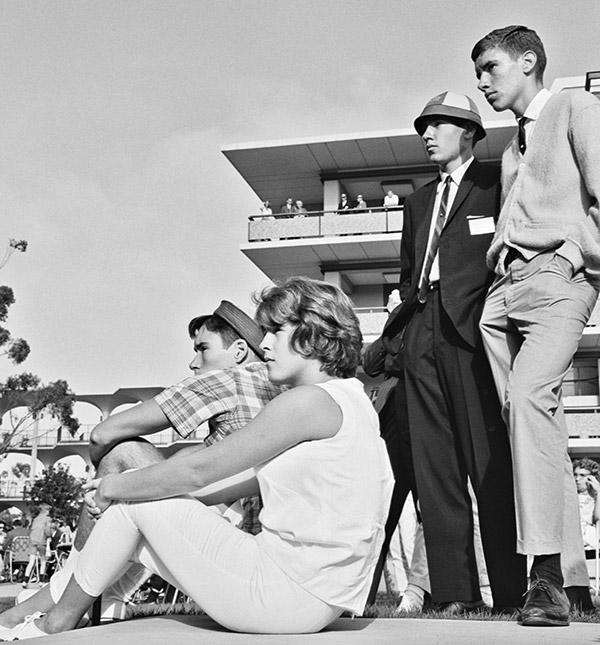
By:
- Christine Clark
Published Date
By:
- Christine Clark
Share This:
Trailblazing Class of ’68 Celebrates 50th Anniversary

This fall marked the 50th Anniversary of the start of classes for UC San Diego’s first undergraduate students.
The class was made up of approximately 180 freshman students, who approached a vastly different campus than the one we have today.
In 1964, there were no freeways near the four-year-old university, which was cleaved in half by U.S. 101. The campus was made up of three academic buildings: B, C, and D (building A was the steam plant), and there were no dormitories. Dirt, not concrete, filled what was later to be known as Revelle Plaza. And construction on the Central Library (later renamed Geisel Library) wouldn’t break ground for another three years.

But even so, 181 pioneering students arrived at the relatively barren mesa on the northern edge of the city. They joined about 280 graduate students, some of whom had been at the university since its founding in 1960.
The first college established on campus was aptly named First College, and it remained so until 1965, when it was dedicated in honor of one of UC San Diego’s founders, Roger Revelle.
But the freshmen of 1964 had not come for the facilities. Part of the lure was the promise of an extraordinary faculty, many of whom were Nobel laureates recruited by Revelle in a series of bold raids on top universities throughout the United States. Like most of the admitted freshman class, Marsha Penner, Revelle ’68, was a standout high school student from San Diego County.
“I was just so thrilled to be accepted because I lived in San Diego and I was so excited to go to a new UC campus in town,” says Penner, who worked in the physics department for 13 years after graduation. “We knew that this was really historic. We would be the first of the school’s undergraduates to start traditions, form the student government and vote on important issues.”
All but 30 of the freshmen were science majors and there were, as a registrar told the press that year, “two boys for every girl.” According to Penner, a philosophy major, who now works as a government property administrator for Raytheon, and Roger Carne, Revelle ’68, a math major, camaraderie was strong amongst the small class.
“Everybody knew everybody, we were all friends,” says Carne, who now works in software development. “We all took the same classes, we were all in the same boat.”
The Revelle College curriculum proved to be interesting, but difficult for the first students.
The administration wanted students to be given a broad undergraduate education in science and mathematics as well as in the humanities. They also felt that undergraduates should have a fluent knowledge of at least one foreign language and take calculus their first year. It was a rigorous curriculum.
“I think everybody would have agreed that it was really, really tough,” says Penner. “Everyone was at the top of their high school class and then all of a sudden, they were thrust together in this experimental academic program.” Though the inaugural undergraduate class was under intense academic pressure, they still managed to have fun.
A campus newspaper, Sandscript, was launched in 1965. Also during this first year, the students voted on a school mascot. The list of names considered included Dolphins, Barracudas, Grizzly Bears, Hornets and Tritons. In the final balloting between Dolphins and Tritons, the Greek God of the Sea won. Subsequently, Sandscript was renamed Triton Times, and the student yearbook was dubbed The Trident.
As far as gathering places went, the beach adjacent to Scripps Institution of Oceanography at La Jolla Shores was it.
Part of the University of California since 1912, Scripps Institution of Oceanography was referred to as “the lower campus.” Students would shuttle from the campus to a small beach house next to the pier—it was a place for students to hang out, play Frisbee and surf. Clyde Ostler, Revelle ’68, was admitted to UC San Diego in 1964 along with four other students from Lakeside High School, all of whom were at the top of their class. Ostler, who earned a M.B.A. from the University of Chicago after graduating with a degree in mathematics from UC San Diego, is now retired after working as a senior executive with a major bank. Remembering those early years, he concedes that the burgeoning campus didn’t have a thriving social scene, but the compensation was that everyone knew each other and often socialized at the beach.
In fact, according to Ostler, it was one of their beach trips that helped pave the way for the establishment of one of UC San Diego’s oldest traditions.
“One time, during the summer of ’64 before we all started school, we spent the day at the beach, and afterwards, we all went to campus and walked to the top of Urey Hall,” Ostler says. “We were lamenting how we didn’t eat the watermelon at the beach, so we decided to come back and toss it.”
The event grabbed the attention of students who later collaborated with Bob Swanson, physics professor, on an experiment to determine what the terminal velocity of a watermelon drop from the seventh floor of Urey Hall would be, and how far the sacrificial fruit would splat.
In the remaining college years of the first freshman class, the campus’s total population nearly doubled each year, growing from 552 students in 1964 to 3,743 students in 1968. Revelle College’s evolution included the addition of dormitories in 1965, which were then referred to as mud huts for their rough-textured exterior. UC San Diego’s second college, named after John Muir, was established in 1967. But it was not just the look of the campus that would change. From 1964 to 1968, college campuses across the country were erupting with student activism in response to the escalation of the Vietnam War. Demonstrations and sit-ins at UC Berkeley and UCLA were gathering attention, and students at UC San Diego voiced their opposition to the war as well.
Carne recalls participating in various anti-war activities. “Back then, if you were a student, you got a deferment,” he says. “But as soon as you graduated, you lost that deferment and were subject to the draft even if you were going to graduate school…I was against the war. As were many in my generation.
“I was involved in the La Jolla march and, at the time, La Jolla was an extremely conservative community,” Carne says, “so residents yelled at us, calling us communists and traitors.”
John McCleary, Revelle ’68, who transferred to UC San Diego as a junior in 1966, to study biology, remembers working at the registrar’s office when a group of students occupied the building for a sit-in.
As part of Revelle College’s development, the paved sweep of Revelle Plaza emerged as the campus crossroads. A European-esque open space, the plaza became the backdrop for protests and the boosting of causes. Students set up tables around its big, square fountain, seeking signatures on petitions to end the war in Vietnam, and to support other causes.
McCleary, who later worked at UC San Diego in computing until he retired in 2006, was a graduate student in 1970 and found himself studying at Revelle on May 10. It was the day George Winne, Jr., a graduating senior in history, chose to self-immolate in Revelle Plaza to protest the war in Vietnam.
“I heard some commotion and went to find out what had happened...It was tragic,” McCleary says. “I think most of the students were shocked. It made me take a step back and rethink what was going on. College years are pretty formative as it is, so all this was affecting people in different ways…it was a defining moment for the campus.” (A memorial to honor student activism for peace was recently unveiled at Revelle College.)
By spring of 1968, 77 members of the original class of 181 students were eligible to participate in the campus’s commencement ceremony.
A group of students, including Ostler, wanted to have a graduation ceremony that reflected what they felt were the values of their pioneering class. “Many of us were the first in our family to graduate, so we wanted to have a celebration with our families. We said ‘let’s do away with cap and gown,’ ‘let’s pick our own speaker’.”
However, according to Ostler, some in the administration balked at the idea of students participating in the graduation ceremony in plain clothes. As a compromise, the university offered to provide caps and gowns free-of-charge, and the students consented to don the traditional commencement wardrobe.
Ostler and Carne both say the years they spent as part of UC San Diego’s first class were some of the best of their lives. Penner echoed similar sentiments and says she still has the UCSD beanie that she received during freshman orientation in 1964. In addition to working on campus for 13 years, Penner earned a second bachelor’s degree from Revelle College in computer science in 1972.
“Having spent decades at UC San Diego, I am continually amazed by the campus,” McCleary says. “The campus founders had really high expectations when constructing the university. I am glad I was lucky enough to be a part of the experience.”
Share This:
You May Also Like
Stay in the Know
Keep up with all the latest from UC San Diego. Subscribe to the newsletter today.


